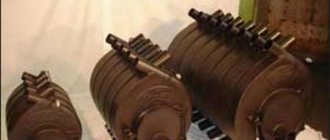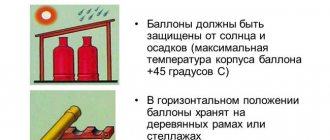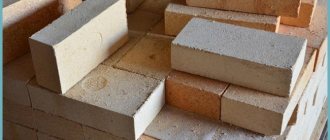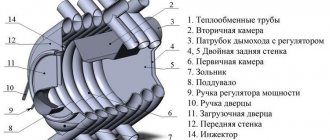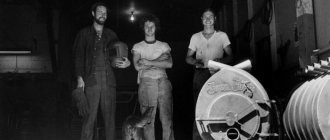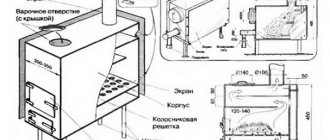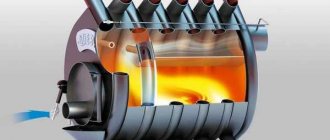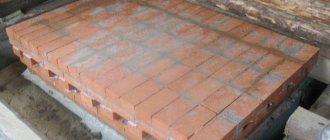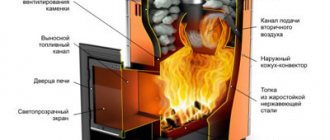Author: Yuriy Fedorovich Kolesnikov, thermal power engineer
The Bullerjan stove (bullerjan, buller, buller, breneran) was not invented by ordinary Canadian guys, as some claim, but by fairly competent heating specialists. The rest of the history of the buller is true: it was actually invented in Canada for the needs of lumberjacks and more on a whim, without further ado. It turned out well, it looks impressive, and there are more than enough people who want to make the buller themselves. This article is written about some of the obstacles and subtleties that may be encountered along this path.
A little history
In Canada, forests are felled not in blocks, but selectively, and teams of lumberjacks lead a nomadic lifestyle. Logging is carried out more in the cold season, when the vegetation does not vegetate, life in the forest comes to a standstill and the damage to forest biocenoses from logging is minimal.
The climate in the Canadian taiga is even harsher than the Siberian one, and even with a 4-hour shift, workers froze into icicles. Comfort and civilization in general in the wilderness is zero. Therefore, lumberjacks needed a heating stove that could be carried with them without cluttering the body, and could be carried into a residential trailer by hand. And this stove was supposed to heat up a housing of 20-30 cubic meters in a maximum of 20 minutes. Waste fuel: branches, wood chips. The firebox is large enough to fit pieces of thick, gnarled logs into it. Operating time from one fill of fuel is at least 8 hours. Where to get up at night and heat it up, when during the day your bones have been broken to the point of pain.
Depending on the weather and season, the heating power must be adjusted. The adjustment should be simple so that it can be performed by an untrained person or after a one-time introductory briefing.
At the same time, the stove had to be inexpensive and quite technologically advanced. Electronics requiring power supply, and automation in general, were excluded: the slightest breakdown in the taiga could cost the lives of an entire brigade. The use of expensive and special equipment-requiring special alloys was also excluded: Buleryan had to be available for production in any mechanical repair shop.
Additional requirements were put forward for operational safety. Firstly, the formation of waste must be excluded under any combustion mode and under any regulations of regulatory authorities. Secondly, the body temperature of the stove should not exceed 60-70 degrees, so that if you accidentally bump into it while asleep and “out of a hangover,” you will not get burned to the point of losing your ability to work. They say that Canadian lumberjacks know how to distill moonshine from pine cones. It's called sterno.
Long burning fuel
Just a few tubes covering the combustion chamber, and we have a Buleryan long-burning stove. It has a very large firebox, so a large amount of fuel can easily be loaded here. One load is enough for several hours of operation, which depends on the power of the unit. Having correctly selected the power for the area, you will lay firewood a maximum of 2-3 times a day, without burdening yourself with unnecessary worries.
Long-term combustion in the Buleryan furnace is ensured not only by the large combustion chamber, but also by the use of a gas generator operating circuit. When the flow of oxygen into the firebox is limited, the firewood begins to smolder, and this process is lengthy. The released pyrolysis gases gradually burn in the upper afterburning chamber, providing support for a certain combustion intensity - you can adjust it with a gate valve and a throttle.
Thanks to the long burning of wood in the Buleryan stove, users have the opportunity to get rid of the constant fuss with loading fuel. If a traditional stove with a small firebox requires new portions of logs every 2-3 hours, then in the case of the Buleryan stove this process will not seem laborious - at least 6-8 hours will pass between approaches for loading wood. This depends on the following factors:
- Volume of loaded logs;
- Burning intensity;
- Outside temperature;
- Wood moisture content.
By adjusting the clearance of the slide damper in the chimney of the Buleryan stove, you can influence the burning rate, focusing on your own temperature preferences and the weather outside.
Buller device
Scheme of the Buleryan stove
Canadian engineers took as a basis the long-known and well-proven design of a slow-burning steel convection-tube air boiler; in common parlance - a heater oven. This is how the design appeared, the diagram of which is shown in Fig. The wide sealed firebox door is equipped with a blower in the form of a pipe with a rotary damper - a throttle. The throttle regulates the furnace power. Sometimes its handle is equipped with a scale, graduated in degrees of outside temperature, and a movable stop-limiter. At the same time, the throttle can be closed tightly if it is necessary to turn off the stove or stop the draft so that the room does not get cold.
Next comes an extensive firebox with curved walls. The batteries of heat exchanger pipes are recessed into them by 2/3 of the diameter. These 2/3 are the first highlight of the buller. With this ratio, 70% of the heat released in the firebox in smoldering mode is released to the air in the pipes. Another 10% spreads over the metal welded body of the furnace and heats the air in addition to them. At a room temperature of 20-25 degrees and a thermal power of 10-20 kW, this requires a temperature gradient of 40-45 degrees, i.e. the body of the furnace will be heated to 60-65 degrees. 5 degrees will give some margin of safety.
At 1/4 of the height of the firebox from the bottom there is a horizontal grate made of thick, at least 4 mm, steel, or a grate made of cast iron grates. At the top, also 1/4 of the height of the firebox, but already from the top, a horizontal partition that is not full in length is welded into the firebox, not reaching its front wall by 1/4-1/5 of the length of the firebox. Holes are made in the partition, precisely calibrated in diameter, location and total area (approximately 7% of the hearth area).
Air intake for afterburning is carried out from the combustion space. There are no separate vents for secondary air. The proportion of air taken by the afterburner from the firebox automatically changes depending on the properties of the fuel and the firebox mode. This is the second difference between the buller and classic designs with combined or separate air flows.
The space fenced off by the upper partition forms an afterburning chamber when operating in smoldering mode. Flue gases from the afterburner exit into the “hog” or “pig” - a horizontal part of the chimney 0.8-1 m long. The hog is mandatory for the buleryan; it somewhat slows down the combustion of the exhaust gases. Why this is necessary will be discussed below.
Immediately after the chimney is turned up, a damper (smoke choke) is installed in it, which switches the combustion mode. Because The heat capacity of the buller body, unlike a brick stove, is small and has almost no effect on heat transfer to the room; there is no view that completely blocks the chimney (and creates the danger of burning out if used carelessly or unskilledly).
Buller gate
The diameter of the chimney is equal to or 10-20% larger than that of the blower pipe, and a quarter is cut out in the damper damper (see figure). Therefore, no matter how you twist the throttle with the damper, the draft will not stop and fumes, even if it is formed, will not enter the room will go, but will fly out into the chimney. With the specified ratio of the diameters of the blower to the chimney and 25% of the area of the idle hole in the damper, the buller is safe, even if you forget to close the firebox door. True, in this case almost all the heat will fly out.
Above the gate is the third most important element of the buller - the economizer. In general, an economizer is a device that heats the working fluid entering the boiler with the residual heat of flue gases - water, air. But in this case, the role of the economizer is different.
The buller economizer is a vertical section of the chimney 1.5-3 m long, well insulated for heat: 40-50 mm of asbestos or basalt cardboard, or 30-40 mm of basalt wool, or 10-15 mm of expanded vermiculite. In the economizer, the flue gases finally burn out: the core of the gas jet in the hog does not have time to cool down too much, the IR reflected from the walls of the economizer increases the concentration of thermal energy in the jet, and the gas flares up. Firefighters are familiar with this effect as flame jumping.
The gas that flares up in the economizer tends to expand, but in a limited volume it has nowhere to go. A gas plug is formed, which is also well known to builders and owners of poorly designed stoves. The combustion in the firebox subsides, the plug cools down, slips through, the combustion intensifies again - the Buleryan, puffing sometimes more often, sometimes less often, automatically adjusts to the quality of the fuel and the position of the air throttle.
They say that this idea dawned on one of the developers while looking at a colleague puffing heavily on his pipe. The design team tried to solve the problem of stability of the combustion mode at low temperatures in the firebox. It was not possible to stay on the verge of smoldering and flame until a self-oscillatory combustion mode was introduced. So a canoe, if rowed alternately with one oar, from one side to the other, moves in a straight line. An overall buller efficiency of 80% is achieved only with an economizer. Without it - at most 60% something.
Sometimes, even often, due to some features of the buller (which will be discussed later), it is operated without an economizer, increasing combustion and putting up with a reduced, but still quite good efficiency. But then a good branded stove only lasts 2-3 years. Why? This will also be discussed further in the course of the presentation.
Popular models of Buleryan stoves
Furnaces based on the use of air pipes are produced under two brands: Buleryan and Breneran. The first established production of stoves was organized, oddly enough, not in Canada, but in Germany. Since 1993, stoves began to be produced in Russia. It has become possible to purchase a Breneran stove since 2005. It was this year that the official Russian stove manufacturer decided to rename the Buleryan stoves. This was due to an improvement in the design of the furnaces and an increase in the warranty period to 2.5 years. At the moment, there are many popular stoves of famous brands.
Stove Buleryan
Breneran AOT-14
This model is one of the most bulky, but capable of heating a large room up to 400 m3. The Breneran AOT-14 model weighs 130 kg, respectively. Although it is worth noting that many stoves designed for smaller spaces weigh an order of magnitude more.
The furnace is made of structural steel. Burning time is up to 10 hours. The combustion chamber is designed for 100 liters of fuel. The length of firewood should not be more than 80 centimeters. The chimney is connected to the back of the stove.
This stove is suitable for heating an entire cottage.
Aqua-Breneran
The Aqua-Breneran model is an improved version of the stove, since heating occurs by heating the circulating liquid.
The stove is suitable not only for heating private houses and garages, but is also installed in workshops and workshops. Such a stove is capable of heating a room of 600 m3. True, a complete filling of flammable materials should be carried out every 6-8 hours.
The structure consists of steel and is coated with heat-resistant paint. Unlike classic stoves, it has an additional water tank. The stove has two regulators. One is located on the door and regulates the heat intensity. The second is on the chimney pipe. This is a gasifier regulator.
Aqua-Breneran is an excellent solution for heating the largest rooms.
Breneran AOT-08 type 005
Buleryan type stoves can be used not only for heating a home, but also for cooking. For these purposes, the company has released a line of stoves with a hob.
This is a gas generator stove, which will help out if there is no stove in the room. It is suitable for heating a room of 100 m3. At the same time, unfortunately, it is impossible to combine two functions - cooking and heating the room. In smoldering mode, Breneran AOT-08 will heat the room within half an hour. And during combustion it is worth using the hob. The hob consists of two burners. Food is prepared quite quickly on this device. For example, a 6-liter container of water will boil in 30 minutes.
Breneran-AQUATEN
The AQUATEN model is a unique stove, the analogues of which cannot be found. The stove is similar in its structure to other Buleryanov models, but still has important differences in its design.
The stove pipes are connected to heating radiators through which water flows. The structure of the pipes is the same as in the air versions of the Buleryan stove. Water rises through the drain to the pipes by gravity. The pressure manifold lifts the liquid up to 8 meters.
Just like other Breneran models, AQUATEN has several heat intensity regulators in the oven. The stove is made of high-strength steel, which is protected from corrosion by a layer of special paint.
In winter, if it is not possible to place solid combustible materials in the stove tank, you can use an electric heating element with a power of 1 kW for heating.
About pipe batteries
With a thermal power of up to 20-25 kW, the pipes in the batteries are made in the form of technologically simple semicircles, as on the left in Fig. In this case, the diameter of the pipes is 60-100 mm, and their number is 3-4 per battery.
Buleryan stoves of low and high power
With a higher thermal power, it is impossible to increase the diameter of the pipes proportionally; due to the low thermal conductivity of the air, the efficiency will decrease. It is necessary to increase the “tube” of the batteries. But with batteries of 6 or more pipes, the efficiency also drops; this is where the square-cube law applies to fuel loading.
Up to a power of 100-120 kW, designers get out of the situation by making pipes curved in the form of sinusoidal arcs and slightly inclined with the top of the arc downward. In this case, the firebox acquires a drop-shaped or ovoid cross-section, as on the right in Fig. With even greater power, computer modeling of the Buleryan with optimization is required, and a positive result of long, complex and expensive work is not guaranteed.
Design features and principle of operation
When developing Brenaran, Canadian specialists used the long-known design of a long-burning convection boiler, called a calorific furnace. Thanks to the increase in the combustion door, it became possible to load not only chopped logs, but also parts of rhizomes, as well as large logs. The new form of the blower - in the form of a pipe embedded in the loading hatch - made it possible to abandon the two-door design. To regulate the amount of air required for fuel combustion, a throttle was installed inside the blower - a round rotary valve. The external throttle control lever allows, if necessary, to reduce or increase the air flow, thereby controlling the power of the buleryan.
Buleryan design
The firebox of the heating unit is a metal cylinder, on both sides of which tubular metal heat exchangers, bent in the form of elbows, are embedded at equal intervals. Due to the fact that two-thirds of the diameter of the pipes are recessed into the body of the stove and are located in the combustion zone, the air receives up to 70% of the heat that is released when burning wood. The remaining kilocalories heat the body of the stove and are subsequently also spent on heating the room. Thanks to this distribution, the body of the buleryan usually heats up to only 60–65 °C, while the air that leaves the convection channels has a temperature of more than 100 °C. It must be said that it is the high heating rate that ensures the active suction of cold air masses in the lower part of the tubular heat exchangers and their release from the upper openings of the heater.
The combustion space inside the device is divided into three chambers. A metal under or removable grate is installed in the lower part of the furnace at a height of up to ¼ of the body diameter. You can do without these elements, but with them it will be easier to light the stove and remove ash. Under the arch of the firebox, at the same distance from the body as underneath, a perforated metal sheet is welded, which does not reach the loading hatch a quarter of the length of the buleryan. The upper chamber is designed for afterburning volatile compounds that are released when the unit operates in gas generator mode.
Rapid heating of the air is ensured by convection heat exchangers that make up the core of the furnace
The combustion products are removed through a hole located in the afterburner chamber, on the side of the rear wall of the unit. A damper with a 90-degree sector cut out is mounted at the beginning of the smoke channel. In addition, around the damper (a metal plate that regulates chimney draft) there is a gap of at least 10–15% of the chimney diameter. This design makes it possible to set the correct draft and at the same time does not allow carbon monoxide to enter the room, even if the smoke channel is completely blocked during intense gas formation.
Increased demands are placed on the buller chimney
A horizontal section of the chimney, designed to reduce the temperature of combustion products, extends from the outlet opening, and then an elbow is installed that directs the pipe vertically. Here, “real” units manufactured by Bulerjan are equipped with a device for pyrolysis combustion of gases, called an economizer. The chimney must be high enough to obtain high-quality draft and insulated so as not to allow the combustion products to cool too much. If this requirement is not met, as well as when using fuel with a high moisture content, the temperature in the afterburning chamber will be reduced, as a result of which the content of tar and other unsafe carbon compounds in the flue gases will increase.
How Buleryan is heated
At first, when it is necessary to quickly warm up the room, dry and fast-burning fuel, such as paper or cardboard, is placed in the firebox. Since pellets went on sale, Canadians, going on their next logging voyage, take 2-3 bags with them; enough for the season.
The throttle and gate are fully opened, the fuel is ignited, and the firebox door is closed. The combustion is fiery, with a “bourgeois” efficiency of 20-40% (and not 5-7%, as advertisers of Buleryans write for comparison). At the same time, 4-6 cubic meters of air per minute, heated to 130-140 degrees, pour out from 4 pipe batteries, and the room quickly warms up.
The accelerating fuel load is given such that it burns down to coals 3-4 minutes before the end of warming up; some experience is needed here. If heat-resistant glass is built into the buller door, combustion can be monitored through it. But it is possible, only inconveniently, to do this by simply peeping into the ash pit.
As soon as the coals have burned down, large logs are placed on them. The bigger the better. You can have one, as long as it fits into the firebox. You can use peat briquettes or the same pellets, they are universal fuel. The blower throttle is now closed to the desired position, or until it stops at the movable power scale limiter. The gate is closed all the way, i.e. at 3/4.
The buller then goes into smoldering mode with partial pyrolysis and gasification. The air leaves the batteries at a temperature of 60-70 degrees, and the furnace body cools down to 50-55. Even if you fall on a bully at night in an Adam costume, you will swear, but you will not get burned.
Calling a buller a pyrolysis or gas generator oven, as is often done, is incorrect. The ratio of heat transferred to the air directly from the smoldering mass of fuel and afterburning pyrolysis gases continuously changes during the combustion of one charge with the throttle and gate position unchanged.
Firebox features
The first is that the thermal conductivity of air is small even compared to its, also small, heat capacity. Therefore, there is no point in “heating up” the buller: the air will not have time to absorb the excess heat, and it will have no choice but to fly out into the chimney.
The optimal temperature in the smoldering mass of the buller is 550-650 degrees. This ensures a fairly high durability of the furnace, welded from ordinary structural steel with a thickness of 4-10 mm, depending on the power. But pyrolysis at this temperature is weak and not complete, which leads to some unnecessary and unpleasant effects. Next we will talk about them in more detail.
If you raise the temperature in the furnace to 800 degrees or higher, then not only the efficiency will drop. And the steel of the housing will not only burn out, but will also undergo thermochemical corrosion due to the presence of hydrocarbon radicals and nitrogen oxides in the flue gases. You can avoid their formation by supplying air separately to the firebox and afterburner, but this will no longer be a buller, but another furnace. Difficult to operate and can be dangerous.
That is why manufacturers of buleryans categorically prohibit burning them with coal and coke. Carbon does not burn if it cools below 800-900 degrees. And if you give more air so that it doesn’t go out, not only will the efficiency drop, but an expensive special steel stove will burn out to holes in a season or two. The claim will not be accepted, the case is not covered by warranty.
Buleryan stoves. Design and operating rules.
The design of a furnace of this type was based on the design of a convection-tube air boiler made of metal belonging to slow combustion systems.
In simple terms, the model was a heater stove. This is how the diagram shown in the figure was born. The wide, hermetically sealed firebox door has a blower made in the form of a pipe equipped with a rotary valve called a throttle. A throttle is required to regulate the furnace power. Some models have a scale on its handle, the graduation of which corresponds to the outside temperature, as well as a movable limiter (stop). The design of the throttle allows it to be closed completely in cases where the stove needs to be turned off or the draft needs to be crossed in order to prevent the room from cooling down.
The next element is a spacious firebox with curved walls. Batteries consisting of heat exchanger pipes are recessed into the walls 2/3 of their diameter. This technical solution can be called the first “highlight” of this design. Since with such a ratio, the air passing through the pipes receives almost 70 percent of the heat. Which in the smoldering mode is released in the firebox. About 10 percent heats the air, spreading over the metal from which the stove is made. If we assume the thermal power to be 10 - 20 kW, and take the temperature in the heated room to be 20-25 degrees, then we will need a temperature gradient of 40 or 45 degrees, therefore, the furnace body will be heated to 60 - 65 degrees (5 degrees - This is a kind of security reserve).
At a distance equal to 25 percent of the total height of the firebox, measured from below, a floor is installed horizontally, made in the form of a grid of 4 mm (or thicker) sheet steel. As a second option, the presence of a grate is considered. At a quarter of the height, now from the upper part of the side of the firebox, a horizontal partition is welded into the firebox body, which does not reach 20 - 25 percent of the total length of the firebox to its front wall. This partition contains holes (precisely calibrated in total area, location and diameter) occupying an area of about seven percent of the total area of the hearth.
Air for afterburning is taken from the same combustion space. There are no special vents for the entry of secondary air into the structure. The afterburner takes different volumes of air from the firebox during different periods of operation. This value changes automatically depending on the selected mode and the properties of the loaded fuel. This can be considered the second significant difference between Buleryans and classic designs, regardless of what air flows are implemented in them: separate or combined.
The space enclosed in the upper part of the body by a partition plays the role of an afterburning chamber in the smoldering mode. From this afterburner, the exhaust gases exit directly into the pig - another name is the hog (this is the name of the horizontally located part of the chimney, which has a length of 800 to 1000 millimeters). The presence of a hog for buleryan is a mandatory condition, since it is he who slows down the combustion rate of exhaust gases. Why this is done, we will consider below.
Immediately after the horizontal section of the chimney is bent upward, a smoke choke (damper) is installed, which serves to switch combustion modes. Unlike brick stoves, the intrinsic heat capacity of stoves of this type is quite small and does not actually affect the values of heat transfer into the room. A view that can block the chimney by 100 percent is not installed to avoid the possibility of carbon monoxide poisoning due to unqualified or careless use.
The diameter of the chimney should at least correspond to the diameter of the blower pipe, or better exceed this value by 10-20 percent, and in the installed damper the damper is cut out to a quarter of its area (see photo). Therefore, in any position, the risk of carbon monoxide poisoning cannot occur and the draft is not interrupted. All gases will go into the pipe. If the internal diameters stated above are observed and the damper quarter sample is checked (in the idle projection), then the Buleryan stove is absolutely safe to use. Even if you forget to close the firebox door. True, in this case, all the heat from the room will quickly end up outside.
The third main structural element of the Buleryan furnace, the economizer, is installed above the damper. Here you need to understand the definitions. An economizer in the generally accepted sense is a technical device that heats the air or water entering the boiler (working fluid), using the residual heat of the exhaust gases. But in a furnace of this design, the economizer plays a slightly different role.
In this design, the economizer is a vertical part of the chimney, ranging from 1500 to 3000 millimeters in length and carefully insulated in terms of heat loss.
The thermal insulation layer is (in different models):
- 40-50 millimeters of basalt cardboard or asbestos;
- 30-40 millimeters of basalt wool;
- 10-15 millimeters of expanded vermiculite.
It is here that the exhaust gases completely burn out. The essence of the process: the middle part of the stream of exhaust gases, passing through the bur, does not completely cool down. Infrared radiation reflected from the walls of the economizer increases the concentration of the remaining thermal energy in the stream and the gas flares up. Firefighters call this effect “flame crossover.”
After combustion, the gas rapidly expands in volume, but this process is limited by metal walls, which leads to the formation of a gas lock. The craftsmen who made illiterately designed stoves of a similar design experienced this from their own sad experience. The combustion subsides, the plug cools down and slips out. This leads to increased combustion, and the stove begins, puffing, (less often - more often) to automatically adjust to the quality of the fuel supplied and the position occupied by the air throttle.
From the outside, this looks like the behavior of a smoker lighting a pipe. A stable combustion mode in cases where the temperature in the firebox became sufficiently low was achieved only after the introduction of a self-oscillating combustion mode. Only then did it become possible to keep the furnace operating on the verge of smoldering and open flame. It is the economizer that allows you to increase the efficiency of buleryans to 80%. Without it, it barely reaches 60 percent.
In some cases, it is necessary to operate the furnace without an economizer. In this case, the maximum period of its operation is reduced to 3 years.
Pipe batteries
In the event that the thermal power of a furnace of the specified design is set to 20 - 25 kW, the pipes placed on the furnace structure are made in the form of technologically simple semicircles (see photo of low-power buleryans). The diameter of the pipes is set in the range of 60 - 100 millimeters, and the required quantity per side is three or four pieces.
If we are talking about the design of a furnace of higher power, it is not possible to solve the issue by simply increasing the diameters of the pipes, because Low thermal conductivity of air reduces efficiency. It remains to increase the number of pipes per battery. But if their number reaches 6 or more, then this also reduces the efficiency (due to the operation of the classic “square-cube” law, which we mentioned earlier in relation to fuel loading)
In furnaces designed for power not exceeding 120 kW. The designers managed to get around these pitfalls by bending the pipes a little differently (along a sinusoidal arc) and tilting them slightly with the top of the arc down. At the same time, the firebox acquired an ovoid cross-section (drop-shaped) in cross-section - see the picture of powerful Buleryan stoves.
In cases where it is necessary to produce an even more powerful furnace, its design is simulated on a computer, calculating the corresponding optimizations. The probability of achieving a positive result is initially estimated at 50%.
How to drown buleryan
In cases where you need to quickly warm up the room, you should put fast-burning dry fuel in the firebox, you can even use cardboard or paper. It is possible to use pellets.
The gate and throttle open completely, the fuel is ignited, and the firebox door closes. At this stage, we observe combustion with an open flame and obtain the efficiency of our stove at a level not exceeding 20-40 percent (typical potbelly stove). A four-pipe battery in this operating mode throws 4-6 cubic meters of air into the room every minute, having a temperature of 130-140 degrees. As a result, the room quickly warms up to comfortable temperatures. The first one. The so-called “accelerating” filling must be determined in volume in such a way that 3–4 minutes before the end of warming up, all the stored fuel burns down to coals. This, of course, requires a certain skill. If your oven door has built-in glass, you can monitor the combustion through it. The second option is possible - to peek through the ashpit. But this option is extremely inconvenient.
As soon as the first stash has burned down to the coals, large logs must be placed on them immediately. Moreover, the larger, the better. You can limit yourself to one very large one, as long as it fits into the firebox. It is fashionable to use peat pellets or briquettes. Now the blower throttle should be closed to the required value, or until it stops at the movable limiter located on the power scale. The gate is closed to its technical maximum (i.e. ¾).
These manipulations switch the furnace to the “smoldering” mode with elements of gasification and pyrolysis. The air leaving the battery is now cooler, “only” 60-70 degrees. The body of the stove itself is even cooler - 50-55 degrees. This is done so as not to accidentally burn yourself on the stove.
It is impossible to call the furnaces designed by Buleryan pyrolysis or gas generators. The fact is that the ratio of heat that is transferred to the air of a heated room from afterburning pyrolysis gases and directly from the smoldering fuel mass is a variable value and changes at each specific moment in time. In this case, the gate and throttle remain in the once selected position.
Firebox features
The thermal conductivity of air is small, even in comparison with its heat capacity. Therefore, there is no point in “stoking” the stove. The air will still not be able to absorb excess heat; it will simply fly out into the chimney (with your supply of firewood).
The optimal temperature of the smoldering fuel mass is 550 - 650 degrees. Therefore, a stove, even welded from simple structural steel (sheet thickness from 4 to 10 millimeters) will last quite a long time. But at this temperature, pyrolysis processes are extremely weak and do not reach completion. This can lead to a number of unpleasant effects.
You can raise the smoldering temperature to 800 degrees. With pyrolysis everything will return to normal, but the efficiency will drop. And the steel body will not only burn out in the near future, but will also suffer thermochemical corrosion. Since the exhaust gases contain nitrogen oxides and hydrocarbon radicals to varying degrees. They can, of course, be avoided. But for this you will need to supply air to the afterburner and the firebox separately. And this is no longer Buleryan. But the oven is of a completely different design, quite complex, and, very likely, extremely dangerous.
This is the main reason why all manufacturers officially producing stoves of this design categorically prohibit the use of coking coals as fuel for these stoves. Carbon, cooling below 800-900 degrees, will not burn. And increasing the air supply, maintaining its combustion, means deliberately reducing the efficiency by a third and burning your stove to holes in one season.
Should I do it myself?
Properly made homemade buller
Before moving on to the features of installing and operating bulleryans, their improvements and varieties, you need to dwell on the question: is it worth making a buller with your own hands? The reason is primarily the selling price of ready-made factory ones. Bullers are very technologically advanced: the zero cycle of their production comes down to the manufacture of a couple of bending templates and welding jigs. The material of the product is even scrap metal.
A very good 10-15 kW Buleryan can be purchased for $200-250. At the same time, equipment that is usual for a camp repair shop is not kept at home, in a garage or on a summer cottage, if only because of the lack of suitable space. And ordering piece-by-piece rather large parts made of thick metal will cost much more.
Perhaps the only exception is if a self-made master works at a remote provincial factory, where most of the technological equipment is still idle. And the “Soviet-style” management will allow him to use the machine park in his free time, and will even allow him to rummage through the landfill and pick up workpieces. Although at current prices for scrap metal this is unlikely.
In this case, we will give advice: do not be tempted by narrow water pipes for batteries. The minimum diameter of air ducts is 60 mm; it is determined by the ratio of heat capacity and viscosity of air. A buller with a “picket fence” is unlikely to be more economical than any other slow-burning stove, but it is more difficult to make. A drawing of a design that is unsuccessful in this regard is shown in Fig. below, and an example of a correctly executed homemade buller is in Fig. on the right at the beginning of the section.
Drawing of an erroneously designed buller
Video: review of homemade buleryan
Ready-to-purchase
Installing a buller in a heated room also has some features. Look at fig. On the left - the option is not entirely successful. And not only because it is necessary to chisel concrete floors, which requires a project with permission, load-bearing structures.
Options for installing a buller indoors
Firstly, to install a chimney passing through the attic and roof, you will need to collect a lot of paperwork in order to obtain permission from the fire department. And then also to comply with all fire safety requirements, which will not be easy or cheap.
Secondly, the condensate that settles from the flue gases of the buller (sludge condensate) has amazing physical and chemical properties. A special section will be devoted to them, but for now we note the following: although there are no separate sanitary rules for this substance, it is better for yourself to stay away from it. And in this case, the sludge condensate remains in the room.
The option on the right is good because you need to drill not into a concrete wall, but into a brick wall. It is, of course, also load-bearing, but it is loaded with less than the ceiling. Control authorities turn a blind eye to an opening in it up to 150 mm in diameter. And the standard diameter of the buller chimney is 100 mm. And getting a fire permit for an external chimney is much easier. And the sludge condensate will be outside.
In both cases, a foundation for the buleryan is not needed; a fireproof stand is sufficient. Other general conditions are as follows:
- The distance from a regular wall is at least 1000 mm.
- If the wall is covered with fire-resistant plaster (for example, vermiculite) with a layer of at least 25 mm, the buller can be moved 800 mm towards it.
- Within a radius of 1200 mm from the center of the firebox door there is a fire-resistant flooring, as for other stoves: steel from 1.5 mm on an asbestos cushion.
- The extension of the stand beyond the contour of the stove is at least 300 mm in all directions.
- If the buller is certified by the fire department for operation without a stand, is equipped with standard non-removable fireproof legs and a pocket-catcher in front of the ash pit door, you can place it without a stand directly on the floor, except for plank wood or plywood. You can use laminate or marmoleum.
Water bullers
Buleryan water boiler
Is it possible to adapt such a really good stove for water heating? It is possible, and water buleryans are produced by industry. But, looking at this (see figure), one inevitably recalls the statement of an outstanding Soviet submarine builder about the project of a giant nuclear-powered missile submarine of the Akula type, also known as the Typhoon: “This is a vivid example of the victory of technology over common sense.”
The authors of “water bullers” forget, or ignore, based on market demands, that buleryan was originally created as an air furnace. And the heat capacity of water is 800 times greater than that of air. In order for the exhaust gases to transfer their heat to it, they need to be entangled in the labyrinth of the water heating register. But in a buleryan with its side-heated heat exchanger, this is basically impossible, otherwise you will have to create a completely different furnace.
The only way to heat water for heating with a boiler is to intensify the combustion in the firebox. But at the same time, as discussed above, the efficiency will inevitably drop.
However, it is very simple to adapt any Buleryan for hot water supply. Let's say we have 2 batteries with 4 pipes each, and the whole furnace is 10 kW. As can be seen in the thermal image (see the figure on the left below), even with intensive heating for rapid heating, the air temperature in the battery nozzles is not higher than 160 degrees.
Thermal image of the Buleryan stove
Now let’s put the most ordinary metal hoses on two pipes and connect them to the pipes passing through the DHW boiler. Horizontally, vertically – it doesn’t matter. 2.5 kW will go into the water. If an 80-100 liter tank is insulated with 40-50 mm thick EPS, then in half an hour the water in it will heat up to 60-70 degrees, and then this temperature will be maintained. For comparison: 3.5-5 kW heating elements are installed in household 100-liter electric boilers.
This system is also good because without any automation, boiling of water is absolutely excluded. Let's remember the school physics problem for the especially (without quotes) gifted and savvy: how to heat water exactly to 100 degrees without letting it boil?
The answer is: take a pan and put wooden blocks in it for thermal insulation. Place another, smaller pan on them. Pour water into both pans and put on fire. The water in the outer pan will boil, but its temperature will not rise above 100 degrees, because... the heat of the fire will be used to transfer the latent heat of evaporation of water to the water.
The water in the inner pan will also heat up to 100 degrees, but there will be no temperature difference between it and the outside, and the heat required to evaporate the water will not be able to transfer to the inner pan. The water in it will heat up to exactly 100 degrees without any signs of boiling.
In the case of a “water buller”, in air with a temperature of 140 degrees there is no reserve of heat to ensure boiling of water. When its temperature approaches 100 degrees, the air in the heat exchanger will rapidly cool, the temperature gradient will approach 0, and the water will never boil.
Buleryan stoves and their design
The solution to the problem came from Canada, a country known for its harsh climate. Truly Siberian frosts constantly reign there, but seasoned Canadians do not pay much attention to the cold. In addition, they invented the Buleryan stove - a wood-burning stove that allows you to warm up a large room or building in a matter of minutes. Today Buleryan has become famous all over the world. It is produced by many manufacturers, despite the presence of a patent from one German manufacturer.
The Buleryan stove is a unique combination of the advantages of a classic potbelly stove, pyrolysis combustion and a convection heater. The combination turned out to be simple and very effective. In fact, the developers added convection tubes to a regular potbelly stove and managed to make sure that the generated heat almost completely went into the air ducts and not into the chimney.
The Buleryan solid fuel stove consists of the following parts:
- Combustion chamber - its volume is approximately ¾ of the total internal volume. This is where the initial ignition of the fuel occurs when Buleryan is just starting up. And here the generation of pyrolysis products takes place;
- Afterburner chamber – in terms of volume, it occupies approximately ¼ of the internal space. Here, under the influence of draft, pyrolysis products enter, which ignite and burn to form a high-temperature flame;
- Injectors - small tubes through which atmospheric air enters the afterburning chamber, are necessary for burning pyrolysis products;
- Convection pipes - the Buleryan stove is a powerful convector, and convection is formed due to thick metal pipes. The inside of these pipes comes into direct contact with burning wood and flames. Due to the large contact area, they select a huge amount of heat, sending it into the premises in the form of powerful convection currents;
- Regulators - these include a slide valve and a throttle on the loading door. Thanks to them, the pyrolysis reaction is maintained in a Buleryan-type furnace - the control elements limit the draft and oxygen supply. At the same time, they are responsible for the intensity of combustion and maintaining a particular temperature;
- The chimney is the simplest part, often equipped with a container to collect condensate. Combustion products are removed through the chimney.
The design of the Buleryan stove is really very simple. Its most important part is the firebox, formed by convection pipes. Most of their area is exposed to heat, which ensures high efficiency of the unit.
Typically, chimneys are purchased or manufactured separately from Buleryan itself. We recommend that you equip the chimney with a condensate collector, building it in a T-shape with a faucet at the bottom.
The principle of Buleryan’s work is incredibly simple and is well illustrated by this picture.
Buleryan is a potbelly stove from Canada, from a country with a cold climate. This means that it has high performance. Initially, such stoves were used by lumberjacks to heat their houses - a comfortable atmosphere in them was achieved due to powerful convection generated by a large amount of heat. Thanks to the simplest scheme, Buleryan can be made independently, using auxiliary tools. But let's see how this oven works.
About heating a private house
Okay, the reader may say, but you need to warm up! Yes, but stove heating is used mainly in private households, and there water heating is pure prejudice, a stereotype of “centralized” thinking. For the efficiency of a central thermal power plant, indeed, the heat capacity of the coolant is of paramount importance, otherwise it will cool down before it reaches subscribers.
What about in a private house? What, should we run a line from the kitchen or furnace around the entire area to the living room/bedroom? Isn’t it easier to disperse the warm air through the rooms, which the bubbler gives, as they say, from the top? Judge for yourself:
- Air ducts can be made with a simple tool from cheap materials: tin, plasterboard, plywood, just cardboard, but pipes are expensive, they need to be bent, boiled, soldered.
- No registers, expansion tank, fittings, or automation are needed.
- You can forget about fistulas and leaks once and for all.
- Ductwork with fans and louvers does not require a design or permit. It is enough to calculate for yourself which section should go into which room.
- Heat transfer into the walls (and this is up to 15% of heat loss through water) is zero; here the poor thermal conductivity of the air works to our advantage.
- Install adjustable blinds at the exits - here you have easy, quick temperature control in rooms. It’s better not to compare it with setting up water heating.
- If you place the exit blinds on the walls farthest from the window above the floor, then the air will give up its heat to the room by the time it gets to where it can heat the street. And everyone knows how batteries in window sills increase the entropy of the Universe.
- The same technique will also provide a warm floor without any additional costs or work.
- The walls are straight, there are no deformities in sight - design the interior as you please.
Video: Buleryan and garage heating
Bullers without pipes
Professor Innokenty Nikolaevich Butakov (not to be confused with Alexander Vladimirovich Butakov, also a professor, but a lawyer) actually invented the Buleryan back in the 20s of the last century, attaching an afterburner to the top of a potbelly stove with a heat shield. Nowadays, stoves such as “Butakov”, “Professor Butakov”, “Student” in modern design (see figure) successfully compete with Buleryans on the domestic market. Their technical characteristics and principle of operation are similar, like identical twins, but making “Butakov” yourself is much easier, as can be seen from the figure.
Convection oven Butakov
Computer buleryan
The first buller was calculated almost on a slide rule. Oddly enough, they were the first to figure out how to properly simulate it on a computer and optimize it in Novosibirsk, at Termofor. Now their “Fire-battery” stoves of various sizes are one of the hits on the market. And it’s not surprising: having carefully calculated all the processes, it was possible to place a hot water circuit for DHW and a hob with a burner in the same tank, see fig.
Stove “Fire battery”
The “Fire-Battery” stoves immediately drew a volley of criticism. But here the complaints of the classics of literature come to mind: “All the same petty attacks on the font, vignettes, typos...”
“It doesn’t correspond to my idea of stoves...” Sorry, sir, there’s no arguing about tastes. “Metal stoves are harmful to health.” By whom, when and where was it proven or at least noticed? “Not a stove, but some kind of boiler for a destroyer.” Sir, you flatter the developers. The best minds in heating engineering worked on boilers for destroyers and cruisers. 70,000 kW in a volume of 8 cubic meters. m. with an efficiency of 97% - if this is not perfection, then what is perfection at all?
What's bad about it?
Yes, the bullers have no visible flaws. That’s what they call it: a stove without flaws. But there is still one hidden one, and a serious one.
Any organic fuel burns, releasing the so-called. reaction water. It is a complete analogue of metabolic water formed in living organisms: it is released during the breakdown of organic molecules. Due to the low temperature in the furnace, there is more reaction water in the exhaust of Buleryan than other slow-burning furnaces; in them this water partially participates in pyrolysis.
The second point is the mineral components of wood. Buller sellers present as an advantage the fact that the wood in the buller burns without even leaving ash. But there is ash in the wood initially, and in bullers, ash particles fly out into the chimney.
The third is hydrocarbon radicals. These are chemically very active remnants of organic molecules that have not completely decomposed. All this taken together reduces the efficiency of the buller by only 5-7% and by volume constitutes the same share of its exhaust. But for household Buleryans, these percentages turn out to be truly lethal.
Let's remember Carnot's formula. If you take a pyrolysis boiler with 1500 degrees in the combustion chamber and 300 in the exhaust, it will show an efficiency of 80%. For Buleryan, the same 80% is obtained at 600 and 120, respectively.
The reaction water from the pyrolysis boiler does not have time to condense in the chimney and dissipates without a trace in the atmosphere. The ash settles under the firebox. From where it has to be raked out from time to time. It contains purely mineral salts suitable for fertilizer. The boiler also produces organic radicals in small quantities, but already 1-2 m from the mouth of the chimney they are oxidized by atmospheric oxygen to carbon dioxide and water, because they were formed at high temperatures and are very light, of low molecular weight
Not so in a buller. The reaction water immediately after the economizer falls into condensate. Each drop of it is a thin film rolled into a lump, and the physical chemistry of thin films is strikingly different from that of massive aggregates of matter. And then there are ash particles, heavy organic radicals. As a result, not just dirty water settles into the sump, but a cocktail of monstrous toxicity, carcinogenicity and God knows what else.
This crap (without quotes) needs to go somewhere. Leaving the end of the “pipe that goes to the ground” open will gradually undermine the foundation, and you won’t be able to eat vegetables from the garden. Slowly take it out and pour it out - the properties of the Buleryan sludge condensate are such that it cannot be hidden from the SES and environmentalists, with all that it implies.
That’s why bullers are also called greenhouse stoves. They are most often installed in greenhouses without an economizer (see figure). Flowers, early and all-season vegetables are highly profitable products; it will not be expensive not only to put up with worse efficiency, but also to change the entire stove in a year or two or three.
Installing a buller without an economizer
True, the exhaust from such a buller still smells, but greenhouses themselves emit methane, ethylene, and so on in the same spirit. Therefore, according to sanitary rules, they cannot be built near residential buildings, so the smoke from the buller does not even require a separate “solution to the issue.”
Some cunning flower growers, especially in places poor in water, judging that tulips, roses and carnations are not eaten, and many plants with luxurious flowers are poisonous in themselves, install bullers according to the full scheme, and the sludge condensate, after slightly filtering, is put into drip irrigation systems. However, tomato and strawberry experiments of this kind always end in resuscitation of buyers, investigation and loud scandals with sanctions, or even prison.
DIY process
Considering the design of the device is not the simplest, it makes sense to draw up a drawing of the Buleryan stove in advance or find a ready-made project, for example, on the Internet. You will have to do a lot of cutting and welding of sheet metal, which requires a welding machine and skills to work with such equipment.
To successfully cut metal, experts recommend using patterns.
To cut sheet metal parts, it is recommended to use cardboard patterns to accurately maintain the dimensions and configuration of the elements
The main material for the manufacture of the Buleryan stove is sheet metal 5-6 mm thick and metal pipes with approximately the same wall thickness and an outer diameter of 50-60 mm.
To give the tubular elements the desired configuration, it is advisable to use a hydraulic pipe bender. To check the position of individual elements relative to each other, use a construction hydraulic level.
For the normal flow of the work process, you will need a number of other devices and materials:
- electrodes for the welding machine;
- pipe cutter;
- roulette;
- marker;
- clamps;
- square;
- ruler;
- Grinder.
They usually start with cutting metal and cutting pipes. Then the remaining metal is removed, and the individual elements are welded together, gradually assembling the furnace.
You need to cut the required number of tubes (for example, eight pieces, depending on the specifics of the project) with a length of 120 cm. Using a pipe bender, they are bent to a radius of 225 mm. The elements of the rear and front walls, doors, regulators and strips for the housing are sequentially cut out of a sheet of metal.
Tubes for the side walls of the Buleryan furnace must be laid on a flat surface and their position must be fixed using wooden beams
The remaining metal is used for the manufacture of door elements, ash pan, pipes, etc. Blanks for the V-shaped chamber are made separately. The metal strips for the body are cut with a width slightly larger than the outer diameter of the tubes. Oval cuts are made at the ends so that they can be welded tightly to the tubes.
The side air ducts are connected at the points of contact by welding, then I install a V-shaped pan inside to separate the secondary combustion chamber
The inlet and outlet pipes can also be made from strips of sheet metal, bent into a ring. An alternative is to simply cut pieces of suitable length from the metal pipe. But its diameter must be larger than that of the structure used for the device body.
Assembly of the device begins with tubes. The correctly bent elements must be laid in a checkerboard pattern so that the back side of the structure is at the bottom and the front side is at the top.
To ensure that the pipes are in the correct position, wooden blocks with a thickness equal to the outer diameter of the metal elements are used.
Bent strips of metal are applied to the side tubes and first welded in some places, and then a continuous weld is made
If the pipes are cut and bent correctly, it will be possible to lay out such a “pyramid” on a level base without any problems. After this, the pipes should be welded to each other at the points of contact.
The resulting structure can now be turned over and a V-shaped pan can be welded in the space between the “ribs”. It will separate the primary combustion chamber from the secondary. An injector should be made in one of the front wall tubes to supply air to the secondary combustion chamber.
A hole is made in the side tube into which a narrow injector is welded to ensure air flow into the second section of the combustion chamber
After this, you can continue to form the stove body by welding the previously cut strips of metal to the ribs. The optimal option is when approximately two-thirds of the pipe diameter is recessed into the body, and a third of these elements remains outside. You will have to tinker with the manufacture of the front wall of the stove.
In the front wall of the Buleryan furnace, a fairly spacious hole is made for the loading door, to which a small side is welded
In the blank for the door, first make a hole for the blower. A pipe is welded to it, in which a damper will be installed to regulate the flow of air entering the primary combustion chamber.
For the damper, you need to cut out a round part, the diameter of which exactly matches the dimensions of the pipe. A pin is welded to the damper. After this, a hole is made in the pipe along the axis into which this pin is inserted.
If the elements of the Buleryan stove are cut and laid correctly, the finished body will look neat. During assembly, you need to control the position of each part using a building level
A hole is made in the blank for the front wall for the door. A narrow strip of metal is welded to it around the circumference.
You need to weld two such strips of metal to the door itself, one along the very edge, the other should be inside at some distance from the first. If everything is done in accordance with the drawings, then the “collar” on the front wall will fit exactly into the gap between the edges of the door.
Two sides are made on the round door, between which the side welded to the front wall of the Buleryan stove must fit exactly
It is recommended to lay asbestos rope in this space to ensure maximum tightness when closing the door. Now you need to weld its inner part to the door, as well as the hinges on one side and the eccentric latch on the other.
The eccentric lock ensures a tight fit of the door to the front wall of the stove for maximum tightness, which is important during long-term burning of wood.
A damper with a damper on the door of the Buleryan furnace allows you to regulate the amount of air entering inside in order to establish the optimal operating mode of the device
It is better for an inexperienced craftsman to order this element from a professional turner. Hinges and a metal pin for the latch are also mounted on the oven body.
Now a double back wall with a hole for the chimney pipe is welded. This element is first applied to the finished structure to make sure that its contours exactly match the outlines of the pipes fastened together.
In order for the dimensions of the door to exactly match the parameters of the hole on the front wall, it is recommended to first weld all the necessary elements of the door and “try on” the dimensions of the side of the loading hole to it
At this stage, you can cut off the excess without any problems. This also applies to other elements - before welding, they are checked for consistency and adjusted if necessary. Now the oven is almost ready. Four legs need to be welded to the body. They can be made from bent pieces of thick wire.
Manufacturing an eccentric latch for the Buleryan oven door requires great precision; it is better to order this element from a good craftsman
The legs are welded to the front and rear walls of the housing. The finished device is installed on a flat and durable base, covered with fire-resistant materials: asbestos, smooth slate, ceramic tiles, etc.
It would also be a good idea to protect the walls around the stove from exposure to high temperatures.
The legs for the body of the Buleryan furnace can be made from very thick wire or bent thin tubes. It is important to give the device stability and correct position
Now a pipe is attached to the chimney pipe and secured with a coupling connection. In this case, the pipes are installed in a position opposite the direction of gas movement, although the manufacturer recommends doing otherwise. It is recommended to insulate the chimney, for example, with mineral wool.
Metal hinges for the Buleryan oven door are not difficult to make yourself from available materials and weld in the required place
